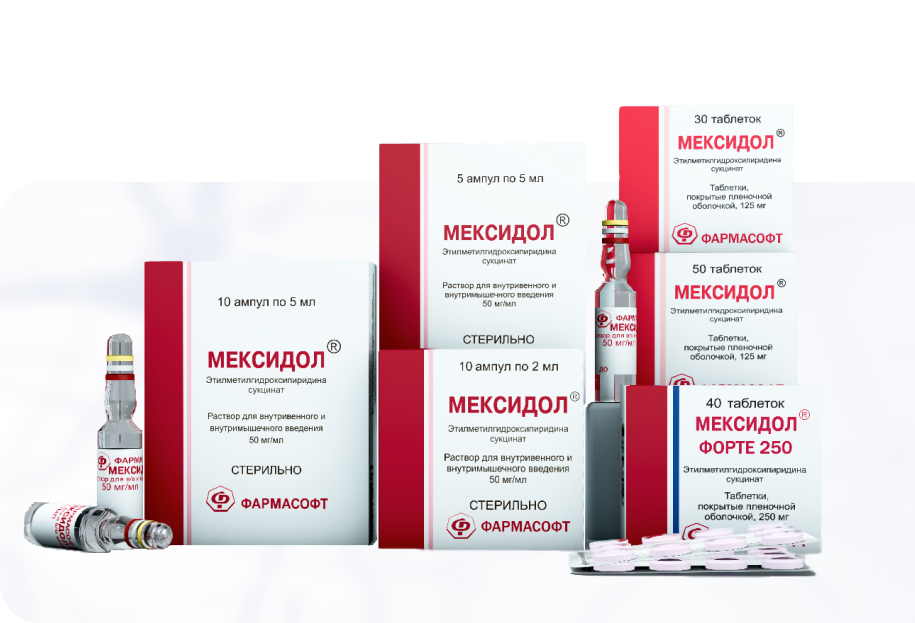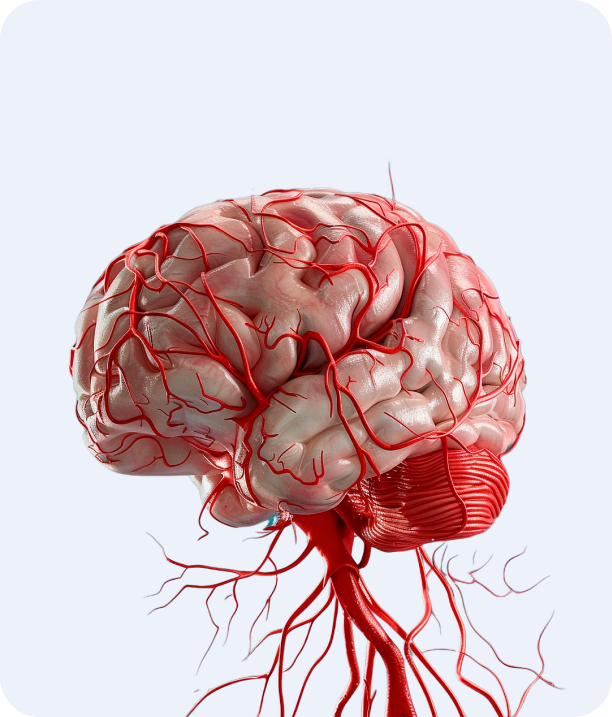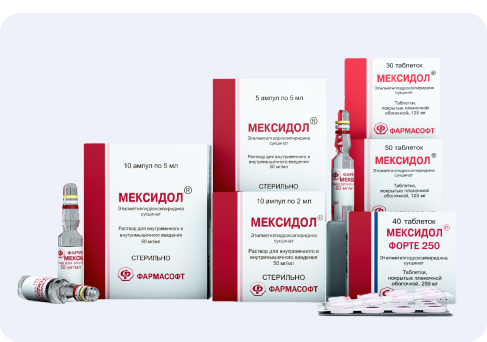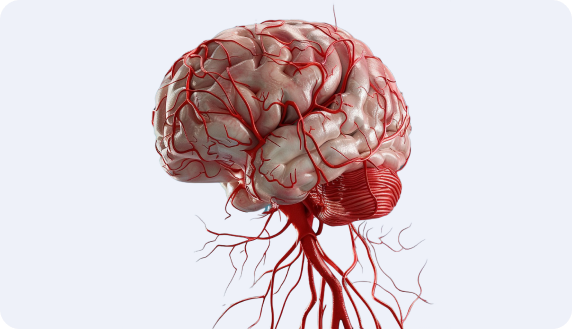There are two main principles of evidence -based medicine - transparency and equality. The transparency lies in the fact that any clinical solution, namely, the choice of a treatment option from possible alternatives, should be based on evidence that can be checked by other people. Equality implies that authority, status and personal experience should not affect the choice of treatment. The choice should be based solely on evidence of the advantages of a particular intervention [5]. Evidence medicine is aimed at the professional growth of doctors by regular formulating issues and mathematical risk assessments.
The effectiveness
of Mexidol®
Evidence base
Evidence medicine is a modern approach to decision making, based on evidence of efficiency and safety, whether it is preventive, diagnostic or therapeutic interventions. Evidence should be evaluated, compared and widespread. These factors help in the provision of optimal medical care to patients. The term "evidence -based medicine" began to be used in 1992 [1]. Evidence medicine is the exact and meaningful use of the best results of clinical studies to make decisions in providing assistance to a particular patient [2, 3]. Not being a new science, evidence -based medicine is a new technology for the collection, analysis and interpretation of scientific information [4].


The principles of evidence -based medicine

Differences in the approach
to evidence
in different countries
In different countries, strategies in the light of evidence are significantly different. For example, in the USA, there is no such thing as unproven medicine. The American Office for the quality of food and medication (Food and Drug Administration (FDA) exercises strict monitoring of compliance with the principles of evidence in registering foods and drugs. According to the FDA, the Russian Federation ranks second after the United States in an absolute number of participants in clinical research (6875) and percentage of the world numbers of clinical research participants (5.22 %) [6].
Nowadays, about 20 % of Russian doctors are guided by the principles of evidence -based medicine. The largest percentage of these specialists is concentrated in large cities. In the regions, this indicator is much less. However, for the successful development of healthcare, the target value of the indicator should be at the level of 75 % [3].
One of the possibilities for improving the situation in the Russian Federation is the introduction of the discipline “evidence -based medicine” in medical universities. Such a course could ensure a more detailed study of the issues of scientific search, levels of evidence of research, medical statistics, work with literature sources, etc.
Levels of evidence -based
medicine
The most important aspect of evidence -based medicine is a system for evaluating the quality of evidence. The hierarchy of the importance of evidence can be represented in the form of a pyramid chart. The pyramid is divided into levels, each of which represents the type of research design. The higher the level, the better and more reliable evidence. That is, as we climb the levels of the pyramid, we become more confident that the results of the study are less susceptible to statistical errors and are more reliable. At the base of the pyramid, there are opinions of experts and clinical cases, at the top of the pyramid - systematic reviews and meta -analyzes (Fig. 1) [7].
Thus, the “gold standard” of evidence -based medicine is randomized controlled studies (RCTs) and their unification, followed by statistical processing - meta -analyzes [8]. The results obtained in these works, as a rule, are not in doubt and are the basis for evidence of the effectiveness/safety of the object being studied.
-
A systematic review of randomized clinical studies using meta -analysis
-
Separate randomized clinical studies and systematic reviews of any design research, with the exception of randomized clinical studies using meta -analysis
-
Inrandomized comparative studies, including cohort studies
-
Incompaling studies, a description of the clinical case or series of cases, the study of "Case-control"
-
Justification of the mechanism of action of intervention (preclinical research) or expert opinion
Figure 1. Pyramid of the level of reliability of evidence (UDD) for therapeutic, rehabilitation, preventive interventions
Clinical recommendations - the main
tool for evidence -based medicine
in making medical decisions
Randomized controlled studies (RCTs) and systematic reviews and meta -analyzes prepared by their results are the creation of clinical recommendations. Clinical recommendations are systematically developed and constantly updated documents, the purpose of which is to assist in making decisions to practicing doctors. Such documents allow us to provide proper medical care in a specific clinical situation and apply the most effective and safe methods of diagnosing and treating patients, including determining the most effective drugs in this clinical situation [9].
Clinical recommendations are the result of a long work of specialists of various specialties. Their main purpose is to give doctors and health organizers the opportunity to apply clinical recommendations to select the most effective therapeutic methods and develop the quality criteria and management of the treatment and diagnostic process. Given the clinical recommendations, the preparation of medical care standards is carried out.
Studies show that clinical recommendations positively affect the quality of medical care and reducing the costs of its provision, including reducing the frequency of complications, the number of patient visits to the doctor and the number of hospitalizations [10].
Clinical recommendations based on the principles of evidence -based medicine are widely used in many countries of the world. They are introduced into the health care systems in the USA, Great Britain, Holland, France, New Zealand and other states [11, 12].
In the Russian Federation, the use of clinical recommendations and providing on their basis the quality of medical care is enshrined at the state level and is a key task of the national project “Health” [13]. The Ministry of Health of the Russian Federation recommends the use of federal clinical recommendations on the provision of medical care posted on the official website of the Russian Ministry of Health https://cr.minzdrav.gov.ru/ . Clinical recommendations are currently actively used not only in clinical practice, but also in the system of subdivolum, postgraduate and continuous medical education [14].
When developing clinical recommendations, scales for evaluating the reliability of evidence (UDD) and/or levels of conviction of recommendations (UUR) are used, which corresponds to international approaches to the development of clinical recommendations in accordance with the principles of evidence -based medicine.
According to the review of the methods for evaluating the reliability of scientific evidence and the conviction of the recommendations used in the development of clinical recommendations in the Russian Federation conducted by N. I. Zhuravleva and co -authors (2019), there is no single approach to the UDD and UUR evaluation in the development of clinical recommendations by professional non -profit medical organizations [14]. The most commonly used UDD and UUR assessment system, when developing clinical recommendations in the Russian Federation, was the SIGN (Scottish Intercolleglate Guidelines Network) scale [15]. In 2009, SIGN switched to the GRADE OF RECOMMENDATIONS ASSESSMENT, Development and EVALUATION) [16].
As a result of the transformation of criteria and evaluation systems in international classifications in the Russian Federation, the following UDD and UUR assessment system (tab. 1, 2) has developed and is actively used in federal clinical recommendations [17]. The ranking of research on the levels of evidence and the level of conviction of recommendations allow us to distinguish effective and safe diagnostic and treatment methods, which are confirmed by scientific research of high methodological quality with a high degree of reliability of the results, the use of which will bring significantly more benefits for patients [18, 19].
Levels of reliability of evidence
Decoding

A systematic review of randomized clinical studies using meta -analysis

Separate randomized clinical studies and systematic reviews of any design research, with the exception of randomized clinical studies using meta -analysis

Inrandomized comparative studies, including cohort studies

Incomparable studies, a description of a clinical case or a series of cases, the study of “case-control”

There is only a substantiation of the mechanism of action of intervention (preclinical research) or expert opinion
Table 1. The scale of evaluation of the level of reliability of evidence for the methods of prevention, treatment, medical rehabilitation, including those based on the use of natural therapeutic factors (preventive, therapeutic, rehabilitation interventions)
The levels of persuasiveness of recommendations
Decoding

A strong recommendation (all the criteria of effectiveness (outcomes) are considered are important, all studies have high or satisfactory methodological quality, their conclusions on the executions of interest are agreed)

A conditional recommendation (not all the criteria for effectiveness (outcomes) are considered, not all studies have high or satisfactory methodological quality and/or their conclusions on interest are not agreed upon)

A weak recommendation (lack of evidence of proper quality (all the criteria of effectiveness (outcomes) under consideration are unimportant, all studies have low methodological quality and their conclusions are not agreed upon for interests))))))))
Table 2. Scales for assessing the levels of persuasiveness of recommendations for methods of prevention, diagnosis, treatment, medical rehabilitation, including those based on the use of natural therapeutic factors (preventive, diagnostic, therapeutic, rehabilitation interventions)
The strongest recommendation and reliability of the evidence are randomized controlled research and meta -analyzes created on their basis. Randomized controlled studies with double or triple “blind” control belong to the so -called I class of research. The materials of these tests and the meta -analysis conducted on their basis should be used in medical practice as a source of the most reliable information [20].
Randomized
controlled tests
in evidence -based medicine
Randomization is understood as a procedure that ensures the accidental distribution of patients into several groups: experimental (main) and control. It is important to note that randomization is carried out after the patient is included in the test in accordance with the protocol of the clinical study [21]. During randomization, a table of random numbers, envelopes method or the path of a centralized computer distribution of treatment options can be used [22]. Thus, in randomized controlled research, participants are distributed by randomly. Some patients fall into the experimental - the main group (for example, therapeutic), while others - in the control (for example, in a group of placebo). Patients take part in the study in strict accordance with the criteria for turning on and non -inclusion according to the research protocol. Both groups are observed for a certain time and analyze the outcomes formulated at the beginning of the study (for example, death, myocardial infarction, cholesterol in serum, etc.). Studies can be one -centered, that is, taking place in one medical or scientific institution, or multicenter - with the participation of several medical or scientific institutions. The advantage of multi -centered research, unlike one -central, is the ability to form a sample uniform on all prognostic signs for a shorter period [23].
Randomized studies can be open and blind (masked). Open - the patient and the doctor immediately after randomization will learn about the type of treatment in this patient.
Blind - the patient is not reported about the form of treatment used. This moment is discussed with the patient in advance upon receipt of informed consent to the study. The doctor will find out what option the patient will receive, after the randomization procedure. When performing a double blind study, neither the doctor nor the patient know which of the interventions is used in a particular patient.
In a triple blind study about the type of intervention, the patient does not know, the doctor and researcher (statistics), treating the results of the study [24]. The results of several randomized controlled studies can be combined. A quantitative analysis of the combined results of several clinical tests of the same intervention is called metaanalysis. It allows you to provide greater statistical power than in each individual test. It is important, however, to remember that the incorrectly conducted meta-analysis can mislead due to the insufficient comparability of groups of patients and the conditions of treatment in various studies [25, 26].
Randomized
controlled
tests of
Mexidol®
Mexidol® (ethylmethylhydroxypyridine succinate) - an original (reference) domestic drug with a powerful anti -identity effect, a unique development of the domestic pharmaceutical industry. Mexidol® has a 25-year clinical experience in successful use in various fields of medicine [27]. The proven effectiveness of the drug Mexidol® and a high security profile are confirmed in numerous studies, including double blind multicenter placebo-controlled (RCTs "Epica", 2017; RCKI "MEMO", 2021, RCT "Mega", 2022 ) that have high levels of reliability of evidence and persuasiveness of recommendations.

Explification of Epica
As a result of the study, the effectiveness of the drug Mexidol® and the safety of prolonged consistent Mexidol® therapy in patients with ischemic stroke in acute and early recovery periods were proved. The data obtained indicate a comparable safety profile of the drug Mexidol® and placebo when used in sequential therapy in patients in the acute and early recovery periods of hemispherical ischemic stroke [28]. In the course of Subanalysis, the safety of long -term sequential therapy by Mexidol was proved in all the age groups of patients under consideration: under 60 years old, 60–75 and 76–90 years old, including patients 60–75 years with arterial hypertension [29].

Research Memo
The results of studies of prolonged sequential therapy with Mexidol® and Mexidol® Forte 250 showed that the drug contributes to the reliable regression of the severity of such the most important manifestations of chronic brain ischemia as cognitive, emotional, autonomic and motor disorders. The safety of long -term sequential therapy with Mexidol® and Mexidol® Forte 250 in patients with chronic brain ischemia has been proven. The growing dynamics of positive changes in the condition of patients of the group 1 (Mexidol®), which reaches the maximum effectiveness by the end of a long sequential therapy (i.e. on the 75th day), was noted, which once again proves the importance of a full course of therapy. Subanaliz by age demonstrated the significant advantages of the drug Mexidol® over a placebo in patients in all age groups: 40–60, 61–75 and 76–90 years. The results indicate the appropriateness of the use of prolonged sequential therapy with Mexidol® and Mexidol® Forte 250 in patients of different ages with chronic brain ischemia [30, 31].

The study of mega
The results have proved the effectiveness of the tablets of Mexidol®, with attention deficiency syndrome in children from 6 to 12 years old according to the scheme: 1 tablet 125 mg 2 times a day for 1.5 months. Repeated courses can be recommended after 2-3 months [32, 33]. The superior effectiveness of the drug Mexidol® over a placebo is proven. When evaluating the main and most secondary criteria for the effectiveness of the treatment scheme “Mexidol® tablets covered with a film membrane, 125 mg 2 times a day” showed its advantage over the “Mexidol® tablets covered with a film membrane, 125 mg 1 time per day”. It was established that against the background of the use of Mexidol®, after 6 weeks of therapy, a comparable nature of the safety profiles of the studied dosing of the drug Mexidol® and placebo was obtained.
Mexidol®
(ethylmethylhydroxypyridine succinate)
in clinical recommendations
Currently, Mexidol® (ethylmethylhydroxypyridine succinate) is included in the following clinical recommendations, which use the URU and UDD assessment system:
Mexidol® (ethylmethylhydroxypyridine succinate) is included in the current clinical recommendations “ischemic stroke and transient ischemic attack in adults”.
In 2024, Mexidol® (ethylmethylhydroxypyridine succinate) was included in clinical recommendations for glaucoma, such as “primary glaucoma, open -angle” with the level of conviction of recommendations (uur) a and the level of reliability of evidence (UDD) 1,
And in the clinical recommendations “Glacom Primary Closing” C Uur C and UDD 5.

Also Mexidol® (ethylmethylhydroxypyridine succinate) is included in the laying of ambulance and in 2 important standards for the provision of medical care, such as an ambulance standard for acute cerebrovascular disorders (Order MZ No. 466 of 05.07.2016) and to the standard of specialized medical care with a cerebral infarction (Order of the Ministry of Health No. 1740N dated 12/29/2012).
List of literature
- Group E-BMW. Evidence-Bassed Medicine. A New Approach to Teaching the Practice of Medicine. Jama. 1992; 268 (17): 2420-2425.
- Persiyanova A.V. The relevance of the development of evidence-based medicine in Russia / A. V. Persiyanova // Science of young-the future of Russia: a collection of scientific articles of the 3rd International Scientific Conference of promising developments of young scientists: in 6 volumes, Kursk, December 11–12, 2018 years. Volume 3. - Kursk: Closed Joint -Stock Company University Book, 2018. - S. 367–371. - Edn ytpujn.
- Fundamentals of evidence -based medicine. A tutorial for the post -off and additional professional education of doctors / under the general editorship of the Academician of the RAMS, Professor R. G. Oganov. -M. Silitsa-Polygraph, 2010.-136 p.
- Talents P.V. 0.05: evidence -based medicine from magic to searching for immortality. - M.: AST: Corpus, 2019. - 560 p. - (Library of the Evolution Foundation). - BBK 54.1. - UDC 616 (G). -ISBN 978-5-17-11411-0.
- Mikulic M. Top 20 Countries by Number of Clinical Trial Participants in 2015–2016. 2021. Accessed January 01, 2021.
- Ettinger A.P., Zharova M.E. What is evidence -based medicine? Evidence gastroenterology. 2021; 10 (1): 38-48.
- Hariton E., Locascio JJ Randomid Controlled Trials - The Gold Standard for Effectiveence Research: Study Design: Randomated Controlled Trita // BJOG. 2018. Vol. 125. No. 13. P. 1716. [PMID: 29916205]
- https://minzdrav.gov.ru/ru
- Lugovaya Yu. S. Clinical recommendations. The world experience of implementation / Yu. S. Lugovoi, O. A. Sukhoruki // Quality Management in medicine. -2019.-No. 1.-S. 26-29. - EDN IYSKOV.
- Woolf Sh, Grol R., Hutchinson A., Eccles M., Grimshaw J. Clinical Guidelines Potential Benefits, Limitations, and Harms of Clinical Guidelines BMJ. 1999. Feb 20; 318 (7182): PP. 527–530.
- Kovaleva M. yu., Sukhorukikh oa klinicheeskie Rekomendatesii. Istoriya sozdaniya i razvitiya v rossiiskoi Fedratsii I Za Rubezhom [Clinical Guidelines. History of Creation and Development in the Russian Federal and Abroad clinical recommendations. The history of the creation and development in the Russian Federation and abroad]. Remedium, 2019, No. 1.
- Passport of the national project "Health". PASPORT NATSIONAL'NOGO Proekta “Zdravookhranenie” [Passport of the National Project “Healthcare”]. Pravitel'stvo RF, Available at.
- Zhuravleva N.I. Overview of methods for assessing the reliability of scientific evidence and persuasiveness of the recommendations used in the development of clinical recommendations in the Russian Federation / N. I. Zhuravlev, L. S. Shubin, O. A. Sukhoruki // Pharmacoeconomics. Modern pharmacoeconomics and pharmacoepidemiology. - 2019. - T. 12, No. 1. - S. 34–41. -DOI 10.17749/2070-4909.2019.12.1.34-41. - Edn Blzonx.
- SIGN 50. A Guideline Developer's Handbook. Scottish Intercollegiaite Guidelines Network - Revised Edition, November 2011, 104 p.
- Applying The Grade Methodology to Sign Guidelines: Core Principles. http://www.sign.ac.uk/pdf/gradeprinciples.pdf]. Canfield SE, Dahm P. Rating the Quality of Evidence and the Strength of Recommentations Using Grade. World J Urol. 2011 29 (3): 311-317.
- Order of the Ministry of Health of the Russian Federation of June 23, 2020 N 617n “On Amendments to Appendices N 1, 2 and 3 to the Order of the Ministry of Health of the Russian Federation of February 28, 2019 N 103n“ On approval of the procedure and deadlines for the development of clinical recommendations, their revision , a standard form of clinical recommendations and requirements for their structure, composition and scientific validity included in the clinical recommendations of information ”.
- The project “Methodological recommendations for the development and updating of clinical recommendations” [Electronic resource]. URL: https://www.cito-priorov.ru/upload/iblock/ee5/12icmdzkr1l79z5vgt8ly8yxo6dbmgj.pdf Date of circulation: 04/16/2024.
- https://kaznmu.edu.kz/.
- Bolyakina G.K., ZAKS I. O. Examples of randomized studies in intensive care (based on the materials of the magazine “Critical Care Medicine” // News of science and technology ser. Medicine. Resuscitation. Intensive therapy. Anesthesiology.– 2002.– 2002.– No. 2.– S. 22–28.
- Graf J., Doig GS, Cook DJ, Vincent J.-L., Sibbald Wj Randomizes, Controlled Clinical Tritisis: Has Methodological Quality Improved Over Time? // crit. Care med. - 2002. - Vol. 30, no 2.– P. 461–472.
- Hebert PC, Cook DJ, Wells G., Marshall J. The Design of Randomized Clinical TritIals in Critically Ill Patients // Chest.– 2002.– Vol. 121.– P. 1290–1300.
- Kanji S., Devlin JW, Piekos Ka, Racine E. Recombinant Human Activated Protein C, DrotReCOGIN ALFA (Activated): A Novel Therapy For Soveree // Pharmacotherapy. - 21001.- Vol. - Vol . 21, No. 11.– P. 1389–1402.].
- Samorodskaya I.V. Clinical studies: controlled and randomized // News of science and technology. Ser. Medicine. Ext. Resuscitation. Intensive therapy. Anesthesiology.– 2002.– No. 2.– S. 19–22.].
- Stupakov I.N., Navodskaya I.V. Randomized research - problems and prospects // Bull. NTCSH them. A. N. Bakuleva RAMS - 2001.– Volume 2, No. 5.– S. 12–15.
- Voronina T. A. Mexidol: a spectrum of pharmacological effects. Journal of neurology and psychiatry named after S. S. Korsakova. 2012; 112 (12): 86-90. Voronina Ta Mexidol: Spectrum of Pharmacological Effects. Journal of Neurology and Psychiatry Named after SS Korsakov. 2012; 112 (12): 86-90. (In Russian.).
- Stakhovskaya L.V., Shamalov N.A., Khasanova D. R., Melnikova E.V., Agafin A.S., Golikov K.V., Bogdanov E.I., Yakupova A.A., Roshkovskaya L . The acute and early recovery periods of the hemisphere ischemic stroke (Epica). Journal of neurology and psychiatry named after S. S. Korsakova. Special letters. 2017; 117 (3-2): 55-65.
- Stakhovskaya L.V., Mkhitaryan E.A., Tkacheva O. N., Ostroumova T. M., Ostroumova O. D. The effectiveness and safety of Mexidol in patients of different age groups in the acute and early recovery periods of the hemispherical ischemic stroke (Subanabaniasis results randomized double blind multicenter placebo-controlled in parallel groups of epic research). Journal of neurology and psychiatry named after S. S. Korsakova. Special letters. 2020; 120 (8): 49–57. https://doi.org/10.1716/jnevro202012008249.
- Fedin A.I., Zakharov V.V., Tanashyan M. M., Chukanova E.I., Majidova E. N., Shchepanevich L. A., Ostroumova O. D. The results of an international multicenter randomized bouncer-controlled Studies of assessing the effectiveness and safety of consistent therapy of patients with chronic brain ischemia drugs Mexidol and Mexidol Forte 250 (study of Memo). Journal of neurology and psychiatry named after S. S. Korsakova. 2021; 121 (11): 7–16. https://doi.org/10.17116/jnevro20211211117
- Zakharov V.V., Tkacheva O. N., Mkhitaryan E.A., Fedin A. I. The effectiveness of Mexidol in patients of different age groups with chronic cerebral ischemia with cognitive impairment (results of subanalysis of the international multicenteric dual-blind-controlled study Memo). Journal of neurology and psychiatry named after S. S. Korsakova. 2022; 122 (11 Issue 2): 73–80. https://doi.org/10.17116/jnevro202222211273.
- Zavadenko N. N., Suvorinova N. Yu., Batysheva T. T., Bykova O. V., Platonova A.N., Gainetdinova D. D., Levitina E.V., Machin V.V., Vakula and Vakula and Vakula and . Journal of neurology and psychiatry named after S. S. Korsakova. 2022; 122 (4): 75–86. https://doi.org/10.17116/jnevro202212204175
- Zavadenko N. N., Suvorinova N. Yu., Zavadenko A. N. The possibilities of using Mexidol in neuropediatrics. Journal of neurology and psychiatry named after S. S. Korsakova. 2023; 123 (9 outp. 2): 1–8. https://doi.org/10.17116/jnevro20231230921
THE INFORMATION IS INTENDED FOR HEALTHCARE AND PHARMACEUTICAL PROFESSIONALS. THIS INFORMATION IS NOT INTENDED AS A SUBSTITUTE FOR MEDICAL ADVICE.
Source of photos and images Shutterstock.com






